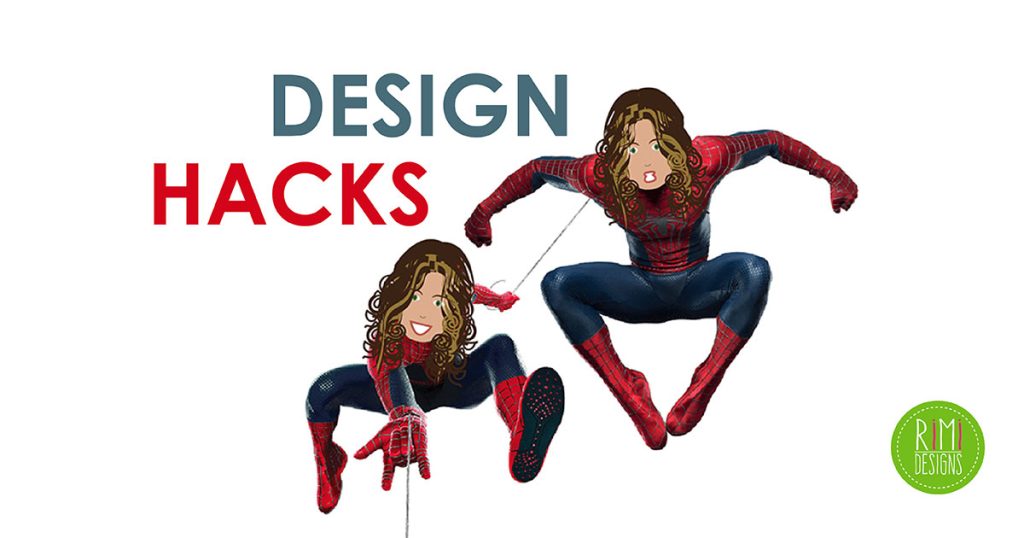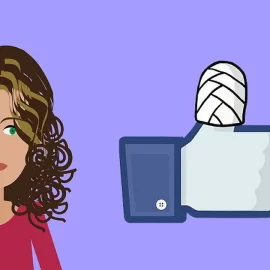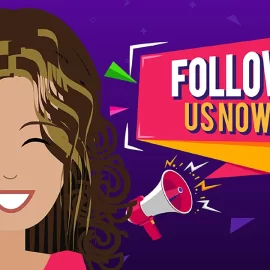
10 Simple Design Hacks to Increase Your Social Media Traffic
These days, almost every business needs to create visual content. Producing regular content has become a key factor in maintaining a successful brand. Whether you write blogs, run a YouTube channek, chat to your customers on Facebook or do all of the above, producing regular content is instrumental to keeping your brand current, engaging and memorable.
But since so many people produce content every day, how are you meant to cut through the noise and make your content stand out? The answer: visual content.
Think about it. Everybody’s single status update looks the same. Sure, the interfaces change over different platforms but, at the end of the day, it’s all just black text on black backgrounds, so it’s all too easy to scroll right past key pieces of content, because nothing quite jumps out.
However, if you used a visual to communicate your message, used a bit of punchy type, a vibrant palette or eye-catching imagery, you have a much better chance of ensuring people will stop scrolling and have a good look.
Basically, you could have the best, most interesting and engaging written content and it could still get lost and ignored, because it looks the exact same as every other piece of content.
Visual content prevents this, though. Visual content gives you free reign to customise your message, use different techniques and mediums to get your message across.
Below are 10 types of visual content you can create right now to get that attention you and your brand deserve.
1. Design your cover photos like a billboard
A captivating and beautiful social media page design can be the difference between somebody following/liking/sharing your page or just ignoring it completely. On social media networks like Facebook, X, Instagram and TikTok, you’re given a customisable cover image that spans across the top of your page, which is a hugely useful tool when used right.
Think of it from your consumers’ standpoint. They’re surfing the web, browsing profiles and scrolling casually, when they land on your page. What’s the first thing they see? Your brand’s name, profile picture and cover photo. This is you making your first impression on that consumer, so it’s pretty important to make it a good one.
So, how do we make sure that we make the most out of this cover photo opportunity? Well, a good way to consider your cover photo is to think of it like a billboard advertising your brand. This is your chance to grab the attention of passers by and pique their interest, flaunt your brand and give these browsing consumers an incentive to scroll further down.
Do you have an interesting show on now or maybe a new product out? Or perhaps you’ve been given some amazing praise that you want to flaunt about. So, just like a billboard, your cover photo should give consumers a taste of who your brand is and what they are doing right this moment.
There’s a few ways to do this, but it basically boils down to this: keep your design consistent with your branding style and tone of voice. Do you have an iconic brand colour or palette? Use it freely and liberally. Do you have a distinct style or tone of photography? Show it off.
2. Keep your design simple
“Keep it simple” is a pretty common piece of design advice across the board. But even if you never heed it anywhere else, at least heed this advice here.
Social media is a fast business. People scroll quickly and they consume content rapidly. So, as consumers, they generally function better by receiving information in short, sharp bursts. This is why it’s a good idea to keep things simple when it comes to visual content.
So, your best chance at creating some truly engaging content that’s quick and easy to consume, is to go simple. Not only will it be effective for consumers’ engagement, it’ll also be way quicker for you to create and by breaking down your information into separate posts, you’ll have plenty of content to post.
While packing your visual content with images, information and data can work for some mediums such as infographics, posting information-dense visual content all day every day can generally get tiring and labouring for consumers. And, on top of that, more complex infographics aren’t always tailored to social media.
So, if you have decided to start designing an infographic with sole purposes of posting it to social media, try to keep it relatively simple. Keep the type large enough that they won’t need to zoom and keep it easy enough to digest and consume in a short amount of time.
So, your safest bet is to keep your message simple and direct. Design your images so they have determined focal points. The fewer words and elements you can use to communicate your message, the stronger your message will be.
3. Show your information, don’t just talk about it
In case you hadn’t heard (or seen), we’ve become a visual culture. We’re all about images now. We consume hundreds upon thousands of them every single day and it’s increasingly becoming a dominant form of communication.
The root of this fascination with images is arguably mostly down to social media. So, it makes sense that for your social media marketing campaign, you should carry that torch and images and visuals wherever you can.
Do you have some information, data or figures you want to post about? Or maybe you have an exciting sale or event happening now? Use some well-designed visuals to capture your audience’s attention.
So, how can we make our designs pop and direct attention to the information? Well, there are a lot of ways we can go about this.
Typographical hierarchy
First of all, make your most important terms the biggest. Is your sale a whopping 70% off? Make that “70%” large and in charge, put it in a big bold typeface and let it be the dominant element in your graphic. Make sure that when people are scrolling by, there will be no uncertain terms as to what your post was about.Use imagery that complements what you’re discussing
Are you posting a commemoration to your product’s biodegradable packaging? Throw in a picture of your product around some greenery and reinforce that environmentally-friendly message through some carefully selected imagery.
So, in short, you want to get as much attention and clicks, as possible. And you can do this with a graphic that highlights the right pieces of information and reflects your message in a thoughtful way.
4. Build visual narratives
Gone are the days when brands were just faceless corporations that aimed to sell, sell, sell. Now, we expect to see more of them. We engage with brands that we relate to their message and they construct and promote a personality and a story, just like a person might do.
Your social media pages are an awesome chance for you to build and construct this personality and story for your brand. Consumers want to connect with your brand, so it’s in your best interest to make that happen by constructing a personality for your brand though visuals.
Do you want to be seen as a natural, free-spirited and environmentally friendly brand? Consider using some photos of nature and the outdoors to boost perception that your brand is pro all things flora and fauna.
A careful selection of images and type can help you construct a distinct personality for your brand.
5. Include strong calls-to-action
So, what is a call-to-action? Well, if you ever sit down and watch an ad, especially an infomercial, I guarantee you will hear 2 or 3 (or maybe even 30 or 40) of them.
A call-to-action is a piece of text that entices audiences to make a move to purchase/consume your product. Some common ones are “Buy now”, “Find it in all good retailers”, “Download today”, etc.
But, a good call-to-action isn’t just about the words used. We mentioned before, how much of a visual culture we are. So it’s more important than ever that you complement that call with an appropriate and effective visual.
Now, what makes a good call-to-action and how can you implement it into your social media design? Well, here are 3 main points that will generally make your call-to-action a winner.
A call-to-action should be engaging
It should make you think about the brand and the product. You can achieve this through visuals and written copy. Use words and images to appeal to your consumers’ emotions, be it nostalgia, humour, happiness or sadness. Find an emotion and build your communication around it.Your call-to-action should be realistic
Don’t say “Buy now and this product will change your entire life” if it probably won’t. Also, don’t show your product doing or achieving something that you know it probably cannot. An honest and reasonable promise is way more effective and enticing than any far-reaching claim.A good call-to-action should be unique
“Buy it now” is a bit bland, unoriginal and doesn’t incite any emotional response or desire to act. Try to think of a new, tailored way to motivate your consumers. Make your call-to-action unique or maybe a little funny. Make it thought-provoking and creative.
Keep an eye out for calls-to-action that grab you and that are effective and try to break down why they work. Is it because of the simplicity of the graphic or the use of hierarchy of the words? Does the copy appeal to an emotion or is it just an intriguing way of inciting action? Deconstruct the most effective examples you can find and then repurpose their techniques to try to make it work for you and your brand.
6. Crowdsource
The beauty of social media is that it’s a two way street. The communication between your brand and consumers works both ways – you can chat to them and they can chat back.
Now, this feature lends itself to awesome opportunities for customer service but another thing it gives you is a chance to capitalise through visual engagements with your audience.
Have you ever been to a show where the performer announced that there would be audience participation? Some hands shoot up, people itching to be chosen and others just like to sit back and watch. Either way, by inviting the audience to participate in the content production, the performer is breaking down that fourth wall and engaging with the audience. What will happen next? Who of us will be chosen?
This is how social media crowdsourcing works. You invite audiences to submit or participate, whether it’s a part of a competition, responses to a question etc., and people immediately engage. They try to figure out what responses or submissions will get the most likes or votes, they browse through others’ responses and they share the visual content around, inviting others to engage.
Consider a way that you could engage with your consumers in a way that reflects your brand. Once you’ve figured that out, present it via a stunning visual that will capture your viewers’ attention and encourage replies and shares.
7. Design specifically for each platform
No two social media sites are the same, this I’m sure you all know. There’s social rules, customs and etiquettes that belong to each platform, but there’s also some more technical differences – namely, image dimensions and sizes.
Have you ever scrolled through X, seen a post that has an accompanying image that has been cropped awkwardly? A crucial part of the image or message is cropped out of the image and you have to click on the image or link to see it in full. While just having to clicking once on an image to see it in full doesn’t seem like a big deal, a lot of people won’t bother to do that, so your awesome visual content is left unseen.
Another frequent case of stunning visuals being hidden by the default social media dimensions is Facebook cover photos. As you’re all aware, your profile picture overlaps the bottom left corner of your cover photo, so that whole corner is wasted space.
While these interface design dimensions can ruin your cover photo design, if you work these elements into your design, you can come up with a really effective design. Treat your images with the respect they deserve and let them shine on all mediums, by just taking a minute to correctly size your images before posting them. Don’t let your beautiful content get hidden by awkward cropping or overlapping elements.
8. Mix up your content
Imagine if you ate the same thing for every meal, every day. You’d get pretty bored pretty easily, right? The same goes for social media content. If you post the same type of thing every single day, people are going to get a little bored. While consistency in your posts is fantastic, don’t take this to mean “only post one type of thing a day”. Instead, mix it up a little.
Do you post a lot of photographs? Perhaps consider posting a few digitally-created graphics, as well. Or maybe you post still images, consider if a video or a GIF might be useful to grab a little attention?
Keep your branding throughout this varied visuals consistent but make the content dynamic and diverse.
9. Let your branding shine on original designs
Modern social media is built upon the sharing and distributing of content. We retweet, repost, regram, reblog, repin posts that we like and that relate to our brands. In fact, we do this so much, that chances are when we repost that quote card or that social experiment video, chances are a majority of our audience has seen it before and will just scroll past.
The benefits of creating original content go far beyond the number of shares, though. By creating your own content, you’re able to tailor it perfectly to your brand and promote exactly what you want to promote. You can use your brand’s palette, typographical style and tone of voice, so that when you post your original content, you’ll be simultaneously reinforcing your brand. Two birds, one stone!
10. Link it back to yourself
You know the saying “no man is an island”? Well, the same goes for social media. No one platform is an island. Social media is a network. Content spans across every platform and most people/businesses don’t just have one social media account but instead they extend themselves across many. So, it’s important to keep that network connected and strong.
But how do we do that? Imagine that you put a lot of work, time and effort into a piece of visual content only to see it 6 months later on somebody else’s blog or page with attributes given to the wrong source. Or even worse, no credit is given at all. What? How frustrating!
While many content creators will take the time to ensure they attribute a source correctly, the sad truth is that many don’t. So, while it’s sometimes a hotly contested device, a watermark of some sort on your visual device can help you avoid this lack of credit. Even if the reposting source doesn’t include any written attributions, your brand mark or details will be right there on the image.
Now, a watermark doesn’t have to be obnoxious, distracting or take up a lot of room Just like you wouldn’t put up your painting on a gallery without signing it, you should be sure that your content is traceable back to you. Whether this means putting your name, your website address, your social media handle or just a logo, consider introducing some form of credit to your own work so that that credit doesn’t get lost.
Bonus tip
If you’re sharing others’ content and can’t find the source, try Google’s reverse image search tool (or just right click on an image and select “Search Google for this image”). Always, always, do your best to credit your sources.
SOURCE: Canva



